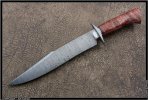So I followed the same process on each of these scales on the middle two knives (except for the top knife which I didn't make. ..but I did polish the blade using the same process as the other knives scales. My process was: Sand to 600 grit and then use some metal polish and a dremel buffing wheel. The bottom knife was only sanded to 600 grit and then NOT polished, but soaked in BLO. I assumed that the problem with using this metal polish on the scales is that it would heat up the wood too much or take off too much material, but I don't think that either the case. The bottom two knives were rubbed out with old english oil and a buffing wheel (with all excess removed) right before the pics were taken. The two wood knives have also been hit with furniture paste wax in the past and it also produced the same finish as what is in the pics.
So my question is, is the second knife from the bottom (that has been sanded to 600 grit and then buffed with metal polish) as glossy as I can get the wood? I have seen wood handled knives that have a high gloss and I am wondering if those have a coating on them.
If I can get glossier (which I assume I can) I wouldn't think it's the polish since the soft bone and heat treated steel both polished up super glossy. Do I need to go to a higher grit sand paper before polishing the wood? I know that some people go as high as 1200 grit, but ???
NOTE: In the second knife from the bottom the black areas (probably stuff that was injected into the stabilized wood) is glossy, the rest of the handle, not so much.
I would like to get glossier wood scales, but I am not sure if what I am missing is higher grit sand paper or better polish specific for the task. Any help would be appreciated.
If you can't tell in the pics,
The top knife has a mirror finish blade. (I didn't make this knife)
The second knife down has an ultra glossy water buffalo horn handle.
The third from the top has a semi-gloss finish with bits of high gloss on the tiny black areas of the wood (and high gloss pins). The black areas are not burnt, its the dye.
The fourth knife down has a satin, but smooth as butter finish.


I sanded my maple top work bench to 600 grit, soaked it in BLO, and then hit it with furniture paste wax and it was finished at a high gloss. ....so what's up with these knives?
So my question is, is the second knife from the bottom (that has been sanded to 600 grit and then buffed with metal polish) as glossy as I can get the wood? I have seen wood handled knives that have a high gloss and I am wondering if those have a coating on them.
If I can get glossier (which I assume I can) I wouldn't think it's the polish since the soft bone and heat treated steel both polished up super glossy. Do I need to go to a higher grit sand paper before polishing the wood? I know that some people go as high as 1200 grit, but ???
NOTE: In the second knife from the bottom the black areas (probably stuff that was injected into the stabilized wood) is glossy, the rest of the handle, not so much.
I would like to get glossier wood scales, but I am not sure if what I am missing is higher grit sand paper or better polish specific for the task. Any help would be appreciated.
If you can't tell in the pics,
The top knife has a mirror finish blade. (I didn't make this knife)
The second knife down has an ultra glossy water buffalo horn handle.
The third from the top has a semi-gloss finish with bits of high gloss on the tiny black areas of the wood (and high gloss pins). The black areas are not burnt, its the dye.
The fourth knife down has a satin, but smooth as butter finish.


I sanded my maple top work bench to 600 grit, soaked it in BLO, and then hit it with furniture paste wax and it was finished at a high gloss. ....so what's up with these knives?
Last edited:


